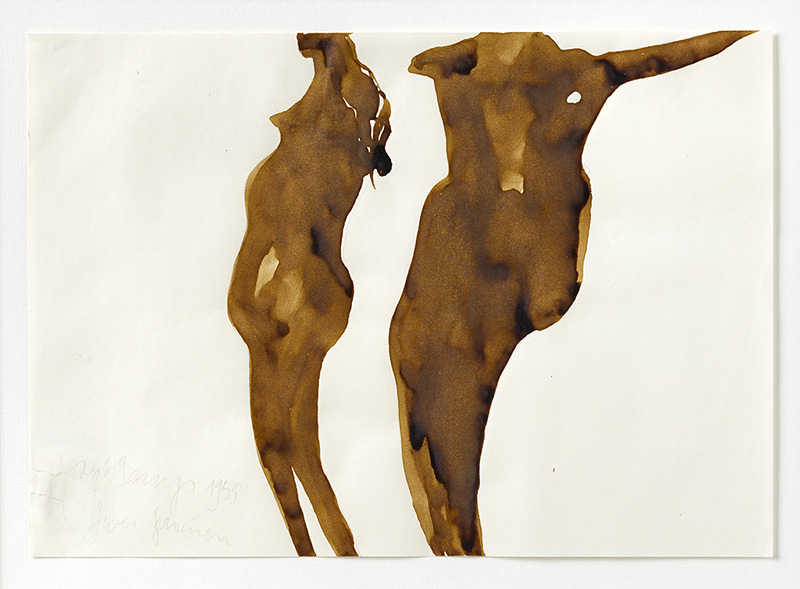ART CITIES:London-Joseph Beuys
 Through a multi-faceted practice that incorporated drawing, sculpture, installations and political activism, Joseph Beuys radically re-conceived the role of theartist, aspiring to a “social sculpture” capable of transforming both individuals and society. Drawing was the catalyst to all his works, considered by the artist as akin to thought and elevated into a living language of creation.
Through a multi-faceted practice that incorporated drawing, sculpture, installations and political activism, Joseph Beuys radically re-conceived the role of theartist, aspiring to a “social sculpture” capable of transforming both individuals and society. Drawing was the catalyst to all his works, considered by the artist as akin to thought and elevated into a living language of creation.
By Dimitris Lempesis
Photo: Galerie Thaddaeus Ropac
The exhibition “Sculpture and Early Drawings” brings together a series of early drawings alongside one of his most import sculptures of Joseph Beuys. The exhibition focuses on the role of the figure in his early works on paper and sculptural practice. The works date from the 1950s, a period of crisis and introspection for Beuys that he considered to be essential to his development as an artist. “The things inside me had to be totally transplanted a physical change had to take place in me, in which old experiences and phases of thought are cast off in order to permit positive changes” he later explained. Working in solitude, Beuys drew prodigiously, searching for an alternative language for art that would be both earthbound and spiritual. His drawings count as one of the most experimental and varied bodies of drawing ever produced. Sparse, precise pencil lines set up an exacting relationship with the sheet that supports them, pools of liquids and an extraordinary diversity of media suffuse the paper with symbolic meaning and a sculptural interchange between solidity and fluidity. The drawings instigated Beuys’s use of unconventional and organic material, exploring the dichotomy of warmth and cold that would, by the end of the decade, become his theory of sculpture. Through a narrowly defined range of motifs, mostly of female figures, landscapes, and animals, Beuys conflated iconography from folklore, mythology, alchemy and the Christian tradition, inscribing these with personal symbolism. Women are promoted to heroic status in the artist’s idiom, representing a greater openness to the future, their supple, bending figures expressive of transformation and fertility. In the watercolor “Untitled” (1955) a female silhouette appears from a subdued swatch of colour, while an animal form hides in the undulating lines of “Schwan” (ca. 1954). Forms and images also come to life thanks to language. Joseph Beuys often uses evocative titles such as “Sternbild des Bären / junger Elch rechts über dem Haus des alten” that shed light on his compositions. Images of animals prevail as well as combinations of the female figure and animal motifs ”Frau/Tierschadel” (1956-57). These depictions can be read as allegories of the unity of humanity and nature. In the 1960s he made a series of drawings with Braunkreuz, which translates from German as “brown cross”, a medium that the artist invented by mixing industrial paint and hare’s blood. For Joseph Beuys, this color symbolises earth as a protective medium. The artist’s use of organic substances demonstrates the centrality of the body in his oeuvre it also gives a material feel to the drawings, linking them to his sculptural modes of expression. The sculpture “Backrest of a fine-limbed person (hare-type) of the 20th Century AD” (1972-82) will converse with the surrounding drawings. Cast in iron from an original plaster form lined with felt that belonged to the daughter of Joseph Beuys’s neighbour, the artist Gotthard Graubner, this object’s original function was a therapeutic backrest used to support an injured body. By reproducing the backrest in iron, Joseph Beuys rendered it shell-like and strong, enhancing its protective resonance. With this sculpture Joseph Beuys addresses individual and universal suffering, as well as the role of art as a means of healing.
Info: Galerie Thaddaeus Ropac, Ely House, 37 Dover Street, London, Duration 28/4-29/7/17, Days & Hours: Tue-Sat 10:00-18:00, www.ropac.net
